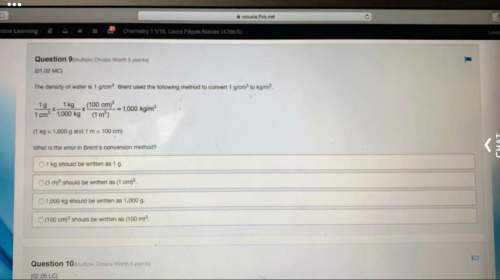
Chemistry, 28.11.2020 09:40 zibnmustafah
Can someone please help me with this?-- 20 pts!
Oxygen has six valence electrons, and an electronegativity of 3.44. Calcium has two valence electrons and an electronegativity of 1.00.
How can the octet rule be used to explain the bonding between them?
Oxygen needs access to two electrons to reach a full octet. Each calcium atom has two valence electrons that it prefers to lose to obtain a full octet. Therefore, one oxygen atom and one calcium atom complement each other and form an ionic bond.
Oxygen needs access to two electrons to reach a full octet. Each calcium atom has two valence electrons that it prefers to lose to obtain a full octet. Therefore, one oxygen atom and one calcium atom complement each other and form a covalent bond.
Oxygen needs to lose six electrons to reach a full octet. Each calcium atom needs access to six electrons to achieve a full octet. One oxygen atom donates all its electrons to calcium, forming an ionic bond.
Oxygen needs to lose six electrons to reach a full octet. Each calcium atom needs access to six electrons to achieve a full octet. One oxygen atom donates all its electrons to calcium, forming a covalent bond.

Answers: 3
Another question on Chemistry

Chemistry, 21.06.2019 20:00
Different isotopes indicate that an element will have different numbers of
Answers: 2

Chemistry, 22.06.2019 01:30
Follow the steps provided in the simulation to add water to the graduated cylinder, select one of the three samples (copper, silver, or gold), set its mass to the values given in the statements below, and calculate its density. here is a summary of the steps required: add water by clicking and holding prepare a known volume of water button. until the desired volume of water has been added. if more than the desired volume is added, click the reset button. button and redo the procedure. a single click will add about 21.0 ml of water. to set the mass, click and hold weigh out metal button. until the desired amount of metal is added to the weighing pan. once the desired mass of the metal is added, release the button. transfer the metal to water and then click on calculate density button. to see how the density is calculated using water displacement to measure the volume of the solid. to save time you can approximate the initial volume of water to â±1 ml and the initial mass of the solid to â±1 g. for example, if you are asked to add 23 ml of water, add between 22 ml and 24 ml. which metals in each of the following sets will have equal density? check all that apply.
Answers: 1

Chemistry, 22.06.2019 11:50
The chemical bond connecting one nucleotide with the next one along the nucleic acid chain is called a
Answers: 3

Chemistry, 22.06.2019 22:30
Which statement best summarizes the importance of ernest rutherford’s gold foil experiment? it proved that all of john dalton’s postulates were true. it verified j. j. thomson’s work on the atomic structure. it showed that an electron circles a nucleus in a fixed-energy orbit. it showed that a nucleus occupies a small part of the whole atom.
Answers: 1
You know the right answer?
Can someone please help me with this?-- 20 pts!
Oxygen has six valence electrons, and an electroneg...
Questions



Biology, 15.01.2021 01:00

History, 15.01.2021 01:00



English, 15.01.2021 01:00

Mathematics, 15.01.2021 01:00

Mathematics, 15.01.2021 01:00

Mathematics, 15.01.2021 01:00

Social Studies, 15.01.2021 01:00






Mathematics, 15.01.2021 01:00

Mathematics, 15.01.2021 01:00

Mathematics, 15.01.2021 01:00

Mathematics, 15.01.2021 01:00





